Viking River Cruise and Tour
China
September 2006

View from our room in the Shanghai Hilton on our first morning. The
construction is typical of Shanghai and other regions that we visited
in China. The lower building with the spire to the right of the two
high-rises was a gift from the Russians in the 1950's.

Old town Shanghai and the Yuyuan Garden dating from the Ming Dynasty.

Rocks in a Chinese garden are especially admired if they are naturally
weathered. Our guide, Steven Shu, called this rock in the Yuyuan
Garden (the tall one in the center) the most beautiful rock in China.

Ginger enjoying Old Town Shanghai.

View of the Pudong district of Shanghai. It is a newly built
financial and commercial center across the river from the older part
of Shanghai. The photo is taken from a walk along the Bund, which is a
famous river road lined with old embassies, banks, and hotels dating
from the early 1900's. The Oriental Pearl Tower dominates the skyline.

Our tour included a visit to a Children's Palace in Shanghai.
These are after-hours schools that operate after regular school
Monday through Saturday and all day Sunday. Parents pay to have their
children receive extra instruction in music, the arts, mathematics,
computer science, and other subjects. This group sang several songs
for us.

This is an even younger group that had trouble holding still but with
the help of their teacher recited a spirited poem for us. The man on
the left with the flag was our Tour Escort, Steven Shu.

Worker in a Silk Carpet Workshop in Shanghai. One worker will spend
from several months to a year or more to handweave one silk carpet
following a pattern as shown in the strip of paper at this woman's
head. Prices vary a great deal depending on the intricacy of the
design and size of the carpet. We bought a small and simple but very
beautiful carpet to hang in our living room.

From Shanghai we flew via Shanghai Airlines to Wuhan, where we visited
a remarkable museum which features artifacts from a tomb from the
Warring States period (over 2200 years old). We heard a musical
performance on the chimes and instruments shown in this photo. The
chimes are replicas of originals which are one of the highlights of
the museum. We bought a CD of music played on the chimes.

Center hallway of our ship, the Viking Century Sky. This trio playing
traditional Chinese instruments greeted us as we embarked in Wuhan,
and they played from time to time throughout the cruise.

Our cabin.

Jim, in front of the Yueyang Tower. The tower is famous because of a
poem, On Yueyang Tower, which was written in 1045 by Fan Zhongyan: the
poem describes "the beauty of the structure and [the poet's] concern
about the country and people." In particular, it says that each
person should care about the happiness of all others.

A highlight of the trip was a visit to a rural "Hope" school in
Jingzhou which is supported by Viking River Cruises. The children
were excited to the point of bursting. As we got off the bus, we were
greeted by this drum and bugle band.

Other children lined our entrance to greet us.

"If you're happy and you know it, clap your hands, ..." Sung in
excellent English!

A class of third or fourth graders, Steven Shu and Ginger up front. The
students were practicing Chinese characters. At this stage, they know
about 800 characters.

The chidren returned to class, but a few lingered to see us off.
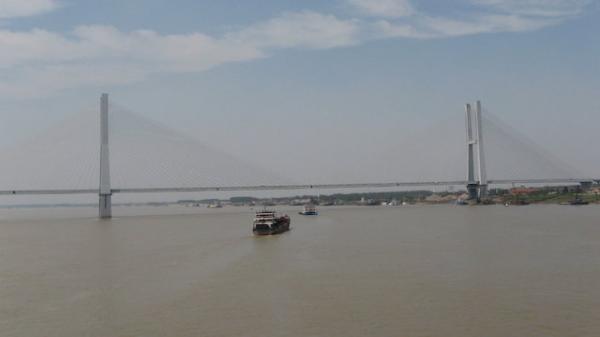
Back on the Yangtze. We saw many bridges of this style.

Ginger and Jim at the Three Gorges Dam.

Model of the Three Gorges Dam project, dam to the left and 5 locks to
the right. The locks are currently free of charge. Between the locks
and dam is an elevator for ships to allow a rapid transit, for a fee.
The original elevator design had problems. The elevator is being
rebuilt by a German firm and should be operational in a few years.

Here our ship has entered the first lock of the Three Gorges Dam, and
we are waiting for other ships to enter. There are five locks, with
four currently in operation. Each lock can handle six large ships or
barges. It takes several hours to get through the five locks. When
the water reaches its final height, all five locks will be needed.

The three gorges themselves are upstream of the dam. The ship
literally sails through the mountains. This is a view from the first
of the three gorges, the longest, called the Xiling Gorge.

A sunset in the Xiling Gorge.

More spectacular than the Three Gorges are the Three Lesser Gorges on
the Daning River, a tributary of the Yangtze. We took a side trip
through the Three Lesser Gorges on a smaller boat. This is in one of
the Three Lesser Gorges.

We saw quite a few monkeys in the Three Lesser Gorges.

High in some of the most precipitous cliffs are "hanging coffins" from
remote times. It is unknown how they were placed in such inaccessible
locations.
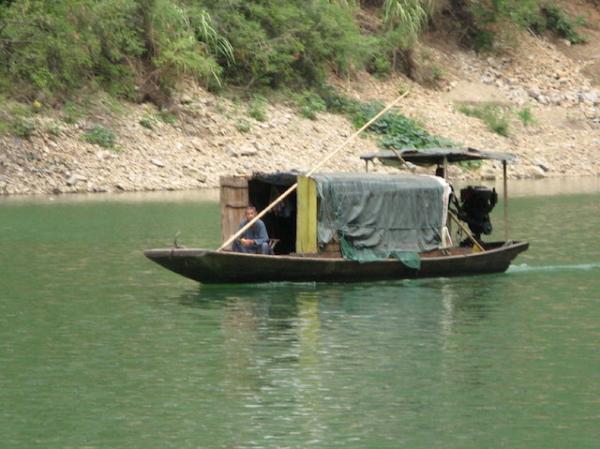
Typical motorized craft used by the locals.

The third school that we visited was the Wanzhou Senior University.
This is a senior center, where people pay a nominal tuition to take
courses in a wide variety of activities. The singing group gave us a
very enthusiastic rendition of a song about Chairman Mao.

A Tai Chi class. We did Tai Chi exercises from 7:30-8:00 AM
each morning on the ship. Mercifully there are no photographs of us.
It was common to see Chinese people doing Tai Chi or other exercises
at the start of the day.

A local market. The shoulder poles and baskets were widely used
everywhere we went and look very efficient. The straps on the basket
are permanent and designed to hook onto the pole. You just fill up
your baskets, slide them onto the poles and go. It was explained to
us that the Chinese are slim because they do so much walking and
bicycling. In the cities they live in high-rise buildings that
typically do not have elevators.

Our ship, the Viking Century Sky. There were no permanent docks
suitable for the ship, even though it has only a 2.6 meter draft (it
is stable to an angle of 15 degrees). The ship always docked next to
an anchored barge.

Another excursion from the ship took us to the Snow Jade Cave, a
remarkable cave discovered only about 10 years ago by two hunters
chasing rabbits. The cave is already very nicely developed for
tourists but a real workout. This is Ginger and some of our group
about to enter the cave.

One of many fine sights in the cave.

The cave excursion was our hardest day physically. The end of the
excursion involved a descent of 250 steps to the ship. To save her
knees, Ginger paid these three men 50 Yuan (about $6.50) to carry her
down in a chair. Several others in our group who had leg problems
also used the service.

Would a trip to China be complete without seeing pandas?
Our final stop on the ship was Chongqing, where we visited the zoo.
The pandas normally do not move much. Our tour escort, Steven Shu,
evidently gave the handler of the pandas something to induce him to
come out and give this panda an apple, a favorite food.
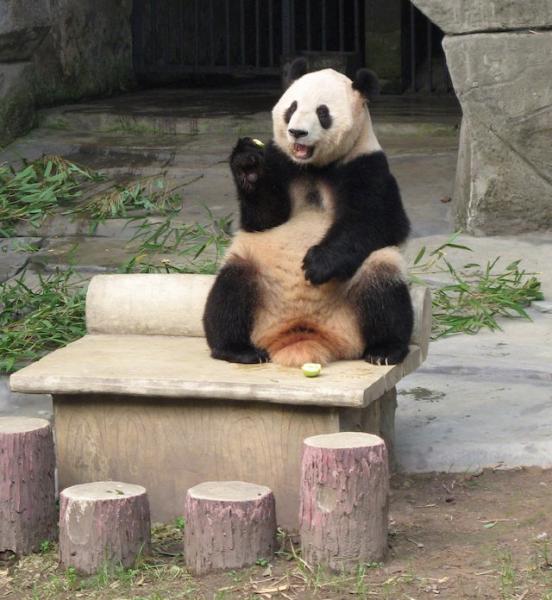
The panda is enjoying his apple.

The staple of the panda is bamboo. In the wild, when the bamboo
flowers (which happens only rarely), it is reportedly a disaster for
the pandas. They will starve before eating bamboo when it is in
flower.

Gotta get a cute panda for Henry!
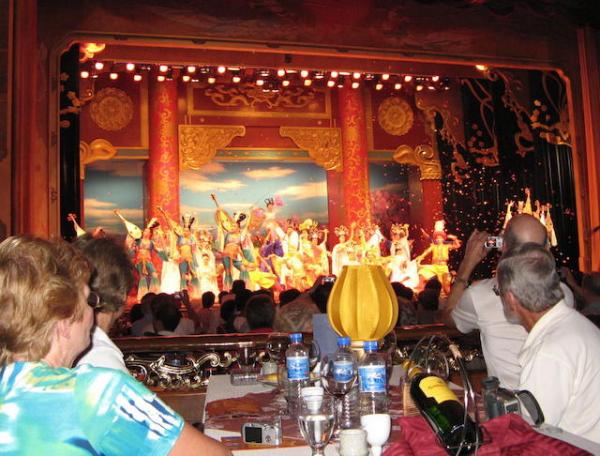
After the zoo visit, we flew via China Airlines to Xian. In the evening
there was a Las Vegas style dinner-show with a Tang dynasty theme.
The highlight was a remarkable pipes player doing a song imitating
birds.

Xian is a famous city more than 2200 years old that retains its city
walls (the city walls of Beijing were torn down to make way for one of
the ring roads of the city). This snapshot was taken from a bus as we
left Xian to see the Terra Cotta Army.

Terra Cotta Army, Pit 1.

A close up showing the individuality of the faces.

This is the state in which the statues were discovered. They had
evidently been intentionally and violently destroyed. Workers are
painstakingly restoring them one by one.

The soldiers in the Terra Cotta Army are larger than life-size. These
horses and the chariot are bronze and half-size. There are two such
chariots. The second is an enclosed one for the emperor, while the
one in the picture is one that precedes the emperor's chariot.

Eleven days into the trip, energy levels were starting to run a little
low. Almost our entire group was sitting in a row here, and just as I
was about to snap the picture our intrepid leader, Steven Shu, called
the group to head out to the airport to catch our China Airways flight
to Beijing. Harvey and Claire, Irene, Betty, Thea, Ann and Dick, Bill and Joan, Ted, and Charlene.

Beijingers love their cars as much as Americans. Traffic is notoriously heavy.

Mandatory tourist photo: Jim and Ginger on the Great Wall.

View through one of the portals on the wall.

A very steep section of the wall. Under the straw hat is Ginger, descending.

We visited a Jade Factory. These horses are carved out of a single piece of jade.

A worker carving a jade piece.

Showroom of the Jade Factory. We bought a simple pendant.

Our afternoon excursion after the Jade Factory was a walk along the
Sacred Way of the Ming Tombs. The way is lined with 18 pairs of
massive stone sculptures. During the Cultural Revolution, the Red
Guards tried to destroy these but failed. The damage that they did
has been repaired.

This statue depicts a man coming to petition the emperor. He holds a
tablet on which is written what he wants to say, so that in awe of the
emperor he will not stammer or forget his request.

Ginger with elephant on the Sacred Way.

Two of our companions, Dorothy and Ralph from Missouri, at the end of
the walk on the Sacred Way.

Mao's tomb on Tiananmen Square. An enormous line of people wait in
line to enter and place a flower inside.
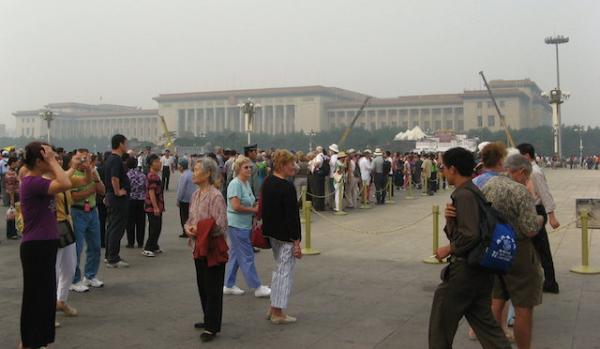
Tiananmen Square and the Great Hall of the People.

Gate of Heavenly Peace (which is the literal meaning of Tian-an-men),
with picture of Mao. The name Tiananmen is the name of the gate and
not really the name of the square. After passing through this gate,
you enter a square that leads to the Meridian Gate, which is an
entrance to the Forbidden City. A visitor to the emperor had to pass
through 9 such gates in order to reach the emperor.

One of many sections of the vast interior of the Forbidden City. Only
the emperor, eunuchs, concubines, and children could sleep inside the
Forbidden City. Concubines drank water from this source.

Another section of the Forbidden City.

This stone was supposed to have special powers. Concubines on their
way to the emperor were to gaze on it and it would then come to them
how to behave.

In the palace gardens.

Lavish Summer Palace restored at great expense by the last empress.
It includes a large lake.

A bridge out to an island in the lake. There are 17 arches. The
number 9 was a special number reserved for the emperor. The emperor's
boat went through the center arch, which is the ninth when you count
from either end. There are many instances of 9 in the Forbidden City.
The gates had large wooden doors with 9 rows of 9 metal bosses.
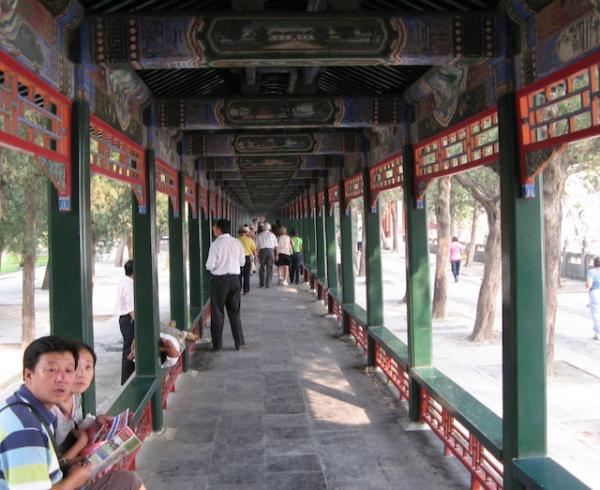
Very long walkway by lake, exquisitely decorated and recently restored.
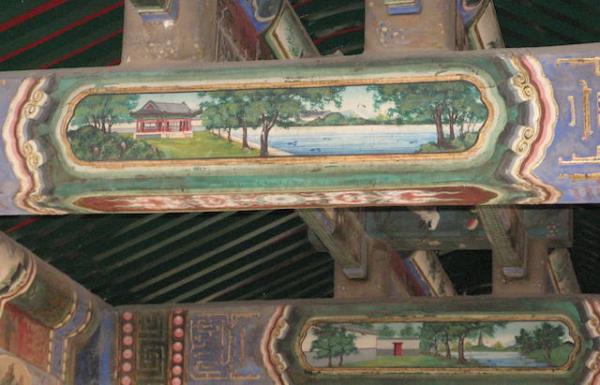
Detail from the long walkway.

On the bus ride back from the Summer Palace, we caught a glimpse of
the Bird's Nest, under construction for the 2008 Olympics. According
to the China Daily, all supports were removed just days before and the
Bird's Nest was standing on its own for the first time.
